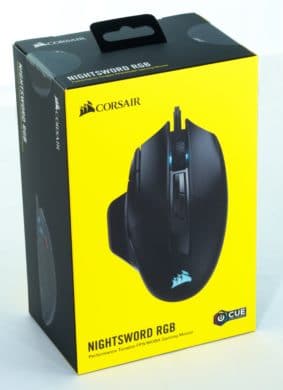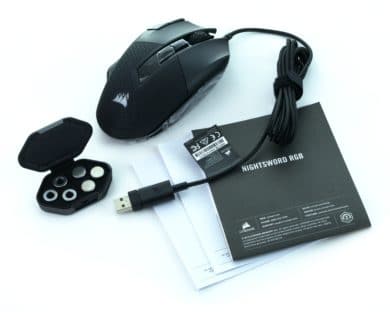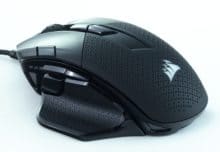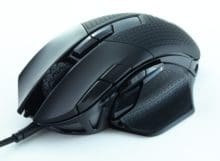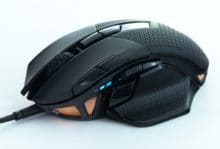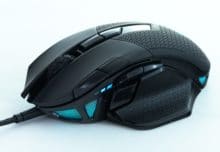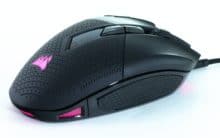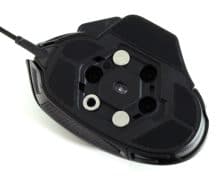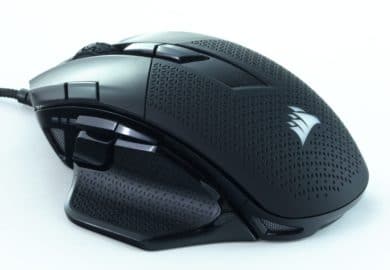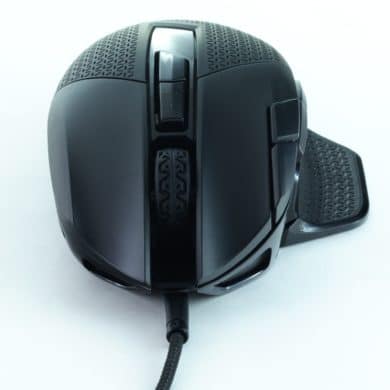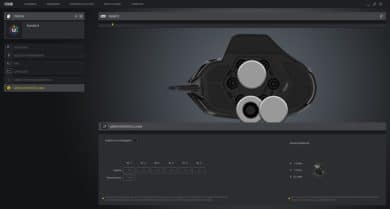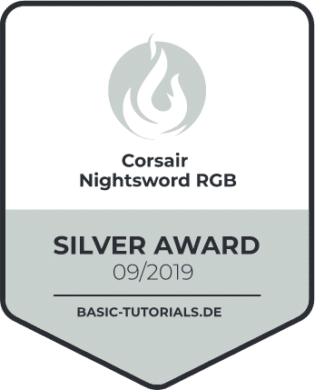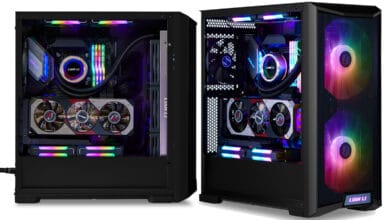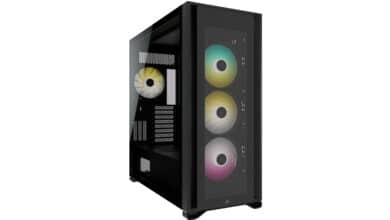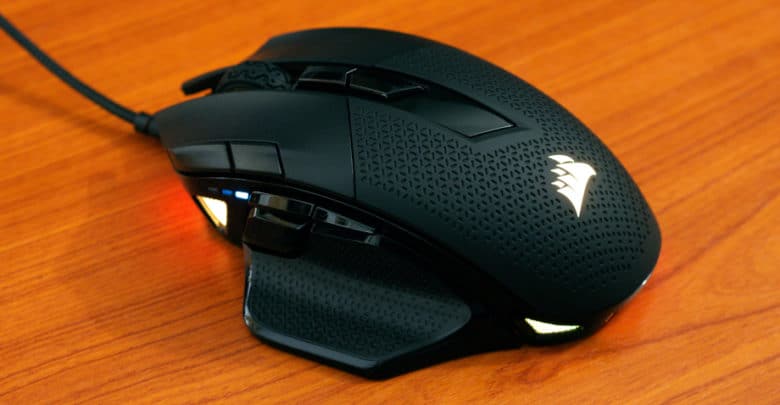
This June, Corsair launched Nightsword RGB, a new mouse designed to complement the company’s high-end segment. The mouse offers a typical equipment package with a high-quality sensor, several additional keys and RGB lighting, but the device should stand out due to something else. Corsair is advertising with a “center of gravity recognition system” that is supposed to recognize the optional weights built into the mouse.
Whether this special feature has advantages and how the currently € 77.10 * expensive mouse performs in practice, we see in the following test.
Scope of Delivery
The Nightsword RGB comes in a typical Corsair package: black cardboard with yellow accents. It contains the usual warranty instructions, a manual and a small plastic case with six weights. Three of them weigh 2.8 grams, the other three 4.5 grams.
Design and Workmanship
The mouse relies on a clear right-handed design. On the left side there are three thumb buttons and also a shelf for this. In addition, there are two additional buttons next to the left mouse button and two behind the mouse wheel – the Nightsword RGB has a total of seven additional buttons.
The right side of the mouse is also adapted for right-handed users: There is a narrow contact area for the ring finger, but the little finger does not have a predefined position, but is simply attached to the case.
Corsair uses several different surfaces for the Nightsword. The two main keys are made of normal matt black plastic. The back of the mouse and the pads for the thumb and the little finger are made of structured rubber. The case itself and the area behind the mouse wheel are made of black high-gloss plastic with the usual advantages and disadvantages: Great looks when it’s clean, but also a high susceptibility to fingerprints and scratches.
There’s a small innovation in the lighting: in addition to the logo on the back of the mouse and the mouse wheel, there are two further lighting zones at the rear and front end of the mouse. These are again divided with struts and provided with a black honeycomb pattern. The latter is only a small change, but it provides a special and in our eyes very appealing optics of the illuminated areas.
The underside of the mouse indicates the great peculiarity of the device: Around the sensor there is a hexagonal cover under which the weight magazines are located. This can simply be removed, then the six possible mounts come to light. The weights can be freely inserted into these as desired.
We have to chalk up a small defect, which our test sample shows: At the back of the mouse, at the edge to the underside, a small part of our model is scratched. This should not be a problem of the production itself, but rather a damage afterwards. Apart from that, the mouse is excellently processed, so one can assume an individual case. In case of doubt, one should nevertheless take a close look at the mouse after the purchase.
Practice
In the Corsairs Nightsword RGB the Pixart PMW 3391 works as a sensor, which Corsair prefers to use in its own mice since this year. Also the Corsair Glaive RGB Pro and the Corsair Ironclaw RGB Wireless that we both tested this summer rely on this sensor.
The PMW 3391 is specified for a maximum resolution of 18,000 DPI and should be able to be adjusted to an accuracy of 1 DPI. In addition, an optional Angle Snapping is offered. In practice, the sensor does a flawless job: all mouse movements are transmitted precisely, there are no triggering errors or distortions. Even with fast actions, movements are implemented without any problems.
Corsair does not recommend any particular type of posture for the Nightsword RGB, so it should be suitable for all three common grip techniques. However, we would only recommend the mouse for the Palm and Fingertip grip, for the Claw grip the contact surface of the ring finger is too narrow. The mouse is very pleasant for users with normal sized hands. What we particularly like about the ergonomics is the rubberized surface, which has a very pleasant feel. If your fingers are longer than average, however, it can happen that the placement of the small finger is difficult – an (optional) contact surface for this would have been even nicer.
The mouse also deserves praise for the placement of the keys: the thumb keys are intuitive and quick to use, whereby the sniper key, on which the thumb rests directly, is not susceptible to false triggers. The front of the two buttons next to the left mouse button is also easy to reach, but the rear button – as well as the two buttons behind the mouse wheel – needs to be gripped slightly.
The pressure point of the main keys is praiseworthy, here the mouse delivers the image familiar from Omron keys. The additional keys, on the other hand, are not all so defined when pressed, but are still in the green range for their intended use.
Software and Weight Detection
The Nightsword RGB also relies on the iCUE software used by Corsair across all products. This is installed quickly and without registration and has a modern, high-performance UI.
In iCUE, numerous settings can be made at the mouse. The three profiles can be freely adjusted, for each of them up to three DPI levels and a sniper mode are available, in addition the lighting and the macros are linked to the profile.
The sensor can be set in the software asynchronously to an exact DPI – optionally also with asynchronous resolution. The illumination settings are also varied: In addition to some standard effects and the possible synchronization with other Corsair devices, we particularly like the fact that the Nightsword RGB can also be assigned its own color to the DPI display and each profile. This makes the mouse a “real” RGB product, while many other models only let the DPI display shine in one color.
The key assignment within the software covers all possible requirements: The keys can be freely assigned to mouse, keyboard or multimedia functions. The macros are virtually unlimited in the software; if you want to save them on the mouse, up to 256 actions are available per macro. This corresponds to 64 keystrokes and is therefore enough for all common applications.
A special subitem of the Nightsword RGB is the weight setting. Here iCUE shows which weights are used at which position and calculates the current center of gravity of the mouse. It’s not more than a nice gimmick, though, because you can’t make any settings here – and even the dream of a real weight measurement isn’t much to feel here. The weights are simply recognized by buttons inside the mouse – for this reason the weights are shaped differently.
The lacking user of the weight measurement does not change the actual advantage of the Nightsword RGB, namely the detailed possible weight adjustment. Due to the widely spread magazines you have a lot of leeway here, if you want to tune your mouse in this respect, you will like this solution.
The bottom line is that the software delivers an (almost) perfect picture. Further detail settings are always conceivable, but the software is undoubtedly a strength of the Nightsword RGB.
Conclusion of the Corsair Nightsword RGB Review
The Corsair Nightsword RGB is a typical Corsair mouse for the upper class: With a total of seven additional buttons, RGB lighting and the usual excellent PMW-3391 sensor from PixArt, it is at eye level with the other models from the manufacturer.
There are differences in detail, especially with the special feature of the mouse: the weight recognition. For the user, however, this means only one possibility for (exact) weight adjustment, but we see only an aesthetic benefit in the software recognition of the weights.
The bottom line is that the Nightsword RGB is only really suitable if you want to adjust the weight and center of gravity of your mouse to your own preference. Then it is an excellent solution. However, if this is not a criterion, you might be better off with other mice – especially in this price segment Corsair offers several similar mice that give you more room for manoeuvre when it comes to ergonomics. Especially with exchangeable side elements you could have gotten a little more out of it.
Corsair Nightsword RGB
Workmanship
Features
Ergonomics
Software
Value for Money
Good features and a unique selling proposition without great benefits
